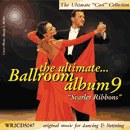Learn to Dance: Tango

The passionate Tango
History of Tango - The exotic Tango is quite interesting in both its history and styling. Its sharp changes of direction and staccato movement evoke visions of passion and drama.
The antique Argentine Tango was influenced by the Tango Habanera. The Habanera came about from two other types of dances: the Milonga, originally an ancient Spanish song form, and the Tango Andaluz (or Tango Flamenco). The Tango Habanera was first heard around 1883 but faded towards the end of the century.
Years later, the Gauchos of Argentina, danced a modified version of the Milonga in the steamy night clubs of Buenos Aires. The story goes that they wore chaps that had hardened from the foam and sweat off the horse’s body. Hence the gauchos walked with knees flexed. They would go to the crowded night clubs and ask the local girls to dance. Since the gaucho hadn't showered, the lady would dance in the crook of the man’s right arm, holding her head back. Sexual innuendo between woman and man were common. Her right hand was held low on his left hip, close to his pocket, looking for a payment for dancing with him. The Tango was an erotic dance, popular with the less than respectable poor and ignored by the upper class.
Around 1912, dancers and orchestras from Buenos Aires traveled to Europe, and the first European Tango craze took place in Paris, where it was transformed into a more polite form of dance, soon followed by London. Vernon and Irene Castle, famous ballroom dancers, helped to elevate its popularity and acceptance into ballrooms. Tango Teas became the craze in London and Paris. Towards the end of 1913 it arrived in New York, in the USA. During the 1920's, Rudolph Valentino added a provocative style that is well known to this day.
The Tango experienced a brief lapse in popularity during the 50's and 60's, but has stormed back in an amazing way thanks in part to the success of Broadway productions and big screen movies. In 1983, following the opening in Paris of the show Tango Argentino, a revolution was felt worldwide and people everywhere started taking tango lessons. Other Broadway Musicals include: Forever Tango, Tango X 2, and Tango Pasion. Movies that featured Tango dancing include “The Scent of a Woman”, Madonna’s “Evita” and “True Lies”.
Tango clubs and organizations continue to grow all over the world and the music is now universal. Its interesting, asymmetrical lines and sophisticated figures, have a flare that has caught the attention of the dance conscious public. Styles include: the authentic Argentine style, the social American style and the European International style.
Music and Tempo - The Tango music is written in 4/4 time and should be played at a tempo at 29-32 measures per minute. The social American Tango rhythm often used: S,S,Q,Q,S
Style - The Tango is a progressive dance characterized by staccato movement and quick changes of direction. The body maintains a slight, but constant, feel of "contra body movement", or C.B.M. The hold is more compact, than in Waltz and Foxtrot, and there is no Rise and Fall.
| Step | Rhythm & Beats |
Foot Movement |
Footwork | Amt of Turn |
Dance Position |
|---|---|---|---|---|---|
| 1 | S-1,2 | LF fwd | H | Slightly turning left (due to CBM) | Closed Dance Position throughout |
| 2 | S-3,4 | RF fwd | H | ||
| 3 | Q-5 | LF fwd | H | ||
| 4 | Q-6 | RF side | IEF | ||
| 5 | S-7,8 | LF close | WF | ||
| Definitions - Click here | |||||
| Step | Rhythm & Beats |
Foot Movement |
Footwork | Amt of Turn |
Dance Position |
|---|---|---|---|---|---|
| 1 | S-1,2 | RF bk | TH | Slightly turning left (due to CBM) | Closed Dance Position throughout |
| 2 | S-3,4 | LF bk | TH | ||
| 3 | Q-5 | RF bk | TH | ||
| 4 | Q-6 | LF side | IEF | ||
| 5 | S-7,8 | RF close | WF | ||
| Definitions - Click here | |||||

 Online Music Store
Online Music Store